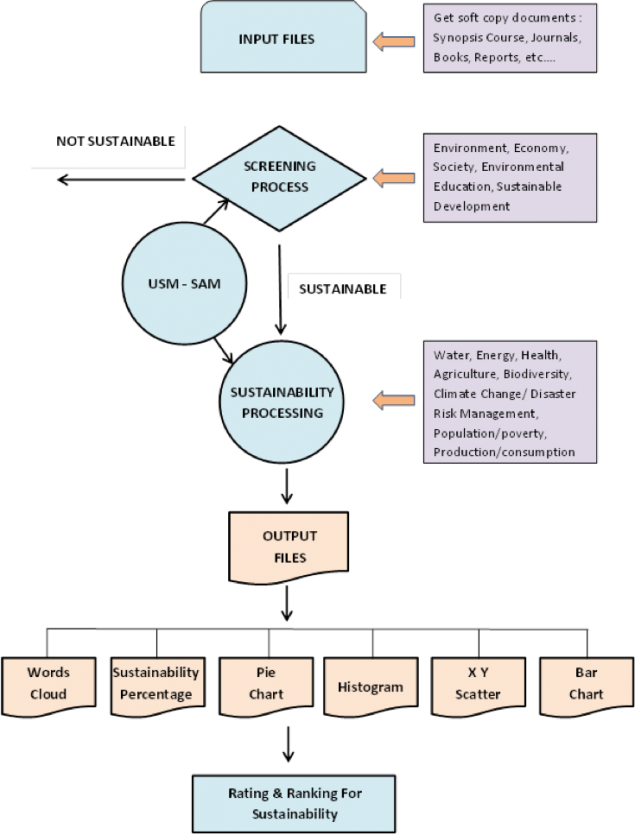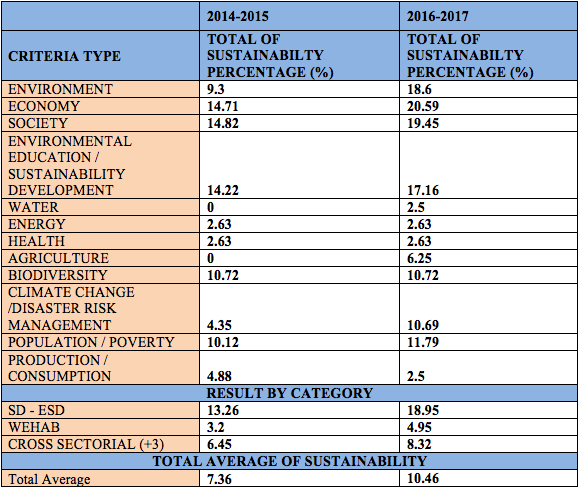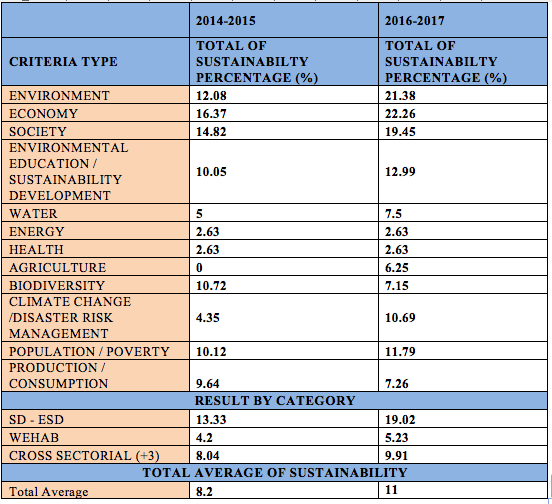Radzi JSE Fall 2017 General PDF [1]
LINK: December 2017 General Issue: Curriculum and Change Table of Contents [2]
- INTRODUCTION
Sustainability and sustainable development have become one of the dominant topics of discussion among individuals, institutions, companies and universities in response to any global issues with regard to climate change. Since the definition of sustainability is still vague, most researchers always refer to the Bruntland Report (WCED, 1987) which came out with the characteristic definition of sustainability: “the development that meets the needs of the present without compromising the ability of future generation to meet their own needs”. Some companies and universities are starting to become more au courant with sustainability aspect in term of the way that the companies and universities are administered and the way the stakeholders work within the said environment. Universiti Sains Malaysia is among the universities which strive on sustainability within the university’s environment. USM has long incorporated sustainability as one of its thrust since 2008 (Razak & Mohamed, 2008) to transform the university into becoming a world class sustainability-led university. The university tries to embark the sustainability aspect in the entire programme offered by the university in order to ensure that the sustainability is adapted within the teaching and learning environment.
The purpose of the paper is to investigate whether USM instils sustainability aspect in the curriculum content of the programmes offered in USM. The paper will focus on assessing the sustainability content in Mathematics programmes offered by the School of Mathematical Sciences, USM. Mathematics programme is chosen as the subject matter because according to Petocz and Reid (2003) there is a lack of effort in integrating mathematics and sustainability together. USM has developed an assessment tool called as World University Sustainability Methodology (WUSA); previously known as Sustainability Assessment Methodology (SAM) to assess the sustainability content of a document in an easy and fast manner. The assessment tool uses indicator-based method to assess the sustainability content in documents such as books, project reports, course synopsis, student’s assignments and many more.
- SUSTAINABILITY IN MATHEMATICS
In the past years, the idea of incorporating sustainability element into mathematics curriculum was hard to be digested by many. According to Petocz and Reid (2003), it was a big challenge back then to accomplish the bizarre idea because it was uncertain to how sustainability role can be infused into mathematics realm as there is no correlation between them. Similar remark has been addressed by Rehmeyer (2011) in the Mathematical and Statistical Challenges for Sustainability report saying that “many other scientists are uncertain of the role that mathematics has to play”. According to the report, some scientists stressed that complex issues with regard to sustainability need to be solved in a more scientific and mathematical way (Rehmeyer, 2011). For example, the number of cow stock that needs to be forecasted to ensure that human beings can get a sufficient supply of beef, requires mathematical skills are in place. As we know, mathematics is important in any real life scenarios such as in business world. Sustainability is also fairly important in any curriculum majors being studied including Mathematics. As years passed by, people especially mathematicians are becoming more aware of the importance of sustainability in Mathematics and efforts have been taken to implant sustainability element into Mathematics curriculum. At Ithaca College (Hamilton and Ptaff, 2014), sustainability element is included in mathematics curriculum courses such as Statistics and Calculus courses. Students who take the any of the course will be taught to use mathematics formula in the context of sustainable issues such as sustainable fisheries as part of the project’s courses. As a result, students will be exposed to sustainability issues and have a chance to ponder on how to make the world a better place which they might have not come across before.
- SUSTAINABILITY AT UNIVERSITI SAINS MALAYSIA (USM)
USM is well known by many for its effort to become the world’s leading university in sustainability which aligned with the university’s vision, “Transforming Higher Education for a Sustainable Tomorrow”. Since 2000, USM has been striving to ensure that the university is progressing in a sustainable way. To ensure the aim doesn’t turn into a sheer rhetoric, USM has enforced several strategies in promoting sustainability elements within the university environment by developing Kampus Sejahtera (Healthy Campus) programme, the University in a garden, instilling sustainability elements in teaching and research activities, taking part in community works and becoming a global player such as becoming a Regional Centre of Expertise on Education for Sustainable Development (Razak and Mohamed, 2008). USM envisions to include sustainability elements in teaching and research activities so that the lecturers, researchers and students could learn how to use their skill in the respective subject area to assist in sustaining the world. Thus, this research will focus on investigating whether USM has successfully embedded sustainability element in the programme courses.
School of Mathematics in USM offers two undergraduate and three postgraduate programmes to its prospective students. The school offers Bachelor of Sciences (Mathematics), Bachelor of Applied Sciences (Mathematics), Master of Science (MSc) in Mathematics, and Master of Science (MSc) in Statistics and Master of Science (MSc) in Teaching of Mathematics.
- RESEARCH METHODS
For the purpose of this study, we utilize a tool that we have developed to investigate the percentage of sustainability content of the bachelor programme offered by the School of Mathematics, USM.
4.1 World University Sustainability Methodology (WUSA) Framework
World University Sustainability Methodology (WUSA) tool has been developed by CGSS to help lecturers, students and other sustainability practitioners to check the percentage of sustainability elements in any document such as assignments, proposals, theses, reports and many more in a fast manner. This will help them to ensure that what they read contains a comprehensive sustainability related topics. Figure 1 illustrates the flowchart of how the system works:
The system used the input process output (IPO) procedure to scan the document and generate the intended result. The process starts by uploading a PDF formatted document to the system. Once the document is uploaded and stored in the database, the screening process will take place. The system will then match each word in the document with the sustainability related keywords stored in the database. The sustainability related keywords consist of words that are used frequently in the internationally agreed documents which are related to sustainability. As of October 2016, 477 frequently used words have been extracted from the said documents and each keyword is categorized into 12 main criteria; Environment, Economy, Society, Environmental Education/ Sustainable Development, Water, Energy, Health, Agriculture, Biodiversity, Climate Change/ Disaster Risk Management, Population/Poverty, and Production/Consumption. After the screening process is completed, the percentage of sustainability element will be generated. The system generates the percentage of sustainability element as a whole and the percentage of sustainability content based on each criterion so that the user can have a better view of which criterion the document is lacking at. The system will also generate several forms of representation; pie chart, histogram, XY Scatter and bar chart.
- RESULT AND FINDINGS
Programme synopsis document for two consecutive academic sessions; 2014-2015 and 2016-2017 were used to determine the sustainability content of the programmes offered in the School of Mathematics, USM. The document contains the description of each course offered in each programmes. Two Bachelor Degree programmes and three Master programmes were chosen namely; Bachelor of Sciences (Mathematics) and Bachelor of Applied Sciences. The results of each document are divided into 12 main criteria.
5.1 Bachelor of Science in Mathematics
Based on the result generated by WUSA, the total average of sustainability content of Bachelor of Science in Mathematics programme has increased from 7.36% in 2014-2015 to 10.46% in 2016-2017.
In term of the criteria type, School of Mathematics has included water and agriculture criteria in the 2016-2017 programme’s syllabus which were not introduced in 2014-2015 programme’s syllabus. Other criteria have also shown a small improvement in term on the percentage of the sustainability content.
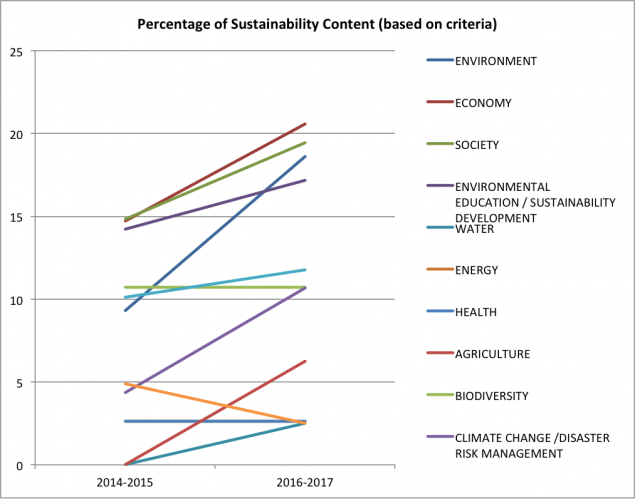 [5]
[5]Figure 2 Percentage of sustainability content based on criteria for Bachelor of Science in Mathematics
School of Mathematics, USM has made an improvement to some of the core criteria such as Environment; from 9.3% to 18.6 %, Economy; from 14.71% to 20.59% and Society; from 14.82% to 19.45%. There are also criteria that did not go through any changes such as Energy & Health which remains at 2.63% and Biodiversity; 10.72%. The percentage of sustainability content for Production / Consumption criteria has dropped from 4.88% to 2.5%. However, it is found that Production/Consumption criteria has decreased from 6.45% to 2.5%.
5.2 Bachelor of Applied Sciences in Mathematics
Based on the result generated by WUSA, the total average of sustainability content of Bachelor of Science in Mathematics programme has increased steadily from 8.2% in year 2014-2015 to 11% in year 2016-2017.
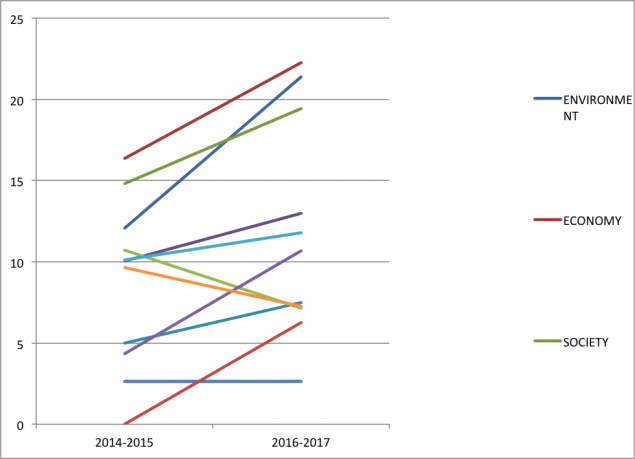 [7]
[7]Figure 3 Percentage of sustainability content based on criteria for Bachelor Applied Sciences in Mathematics
In term of the criteria for both academic years, some of the criteria types have a steady increase of sustainability percentage such as Environment, Economy, Society, Environmental Education/ Sustainability Development, Water, Climate Change/Disaster Risk Management, and Population/ Poverty. The school has included agriculture aspect into the programme’s syllabus in 2016-2017 which was not introduced in 2014-2015 programme’s syllabus. However, it is found that the school has reduced the sustainability content of a few criterions which are Biodiversity and Production/Consumption criteria.
- LIMITATION
This study only use the programme book for each of the Bachelor programme which consist of the list of courses offered by each programme as well as the description of each course offered as the sample document to be tested with WUSA tool.
- RECOMMENDATION AND FUTURE WORK
Based on the programme book for two consecutive academic years, we suggest that the School of Mathematics, USM to put more emphasize on sustainability content in its courses to achieve the university’s vision which is to transform higher education for a sustainable tomorrow. For future works, we could test the student’s assignment document; which might further elaborate what the student has learnt from any of the courses, in WUSA in order to further strengthen the research’s aim.
- CONCLUSION
This study is conducted to investigate the level of sustainability content of Bachelor programmes offered in the School of Mathematics in USM. We have developed a tool called World University Sustainability Assessment (WUSA) to calculate the percentage of sustainability content of any document. We chose two programme’s syllabus document for academic year 2014-2015 and 2016-2017 as our sample document to carry out the experiment to investigate whether or not there is an improvement in term of sustainability content in both document. Our WUSA tool generated the result which showed that there is a small improvement for both academic years for each Bachelor programme. For Bachelor of Science in Mathematics, the percentage of sustainability content improved from 7.36% to 10.46% while for Bachelor Applied Sciences in Mathematics, the percentage of sustainability content improved from 8.2% to 11%. Even though the percentage of sustainability content is way below average and unsatisfactory, the small improvement showed that the School in Mathematics in USM is slowly instilling sustainability element in its programmes to ensure that the school is aligned with the university’s vision; Transforming Higher Education for a Sustainable Tomorrow.
REFERENCES
Brundtland Commission, World Commission on Environment and Development (WCED). (1987). Our Common Future. Oxford: Oxford University Press.
Hamilton, J. and Ptaff, T. J. (2014). Sustainability Education: The What and How for Mathematics. PRIMUS, 24 (1), 61–80. Retrieved from http://dx.doi.org/10.1080/10511970.2013.834526 [8] on 20 December 2016.
Petocz, P. and Reid, A. (2003). What on earth is sustainability in mathematics. New Zealand Journal of Mathematics, 32 (Supplementary Issues), 135-144. Retrieved from https://www.researchgate.net/publication/228587372_What_on_earth_is_sustainability_in_mathematics [9]? 20 December 2016
Razak, D.A. and Mohamed, R. (2008). Shifting rhetorics into reality: transforming higher education for sustainable development – Universiti Sains Malaysia in the APEX framework. Retrieved from http://www.unescobkk.org/fileadmin/user_upload/apeid/workshops/macao08/papers/2-a-1.pdf [10] on 20 December 2016
Rehmeyer, J. (2011). Mathematical and Statistical Challenges for Sustainability. Retrieved from http://dimacs.rutgers.edu/SustainabilityReport/SustainabilityReport_Final08-02.pdf [11] on 21 December 2016.
